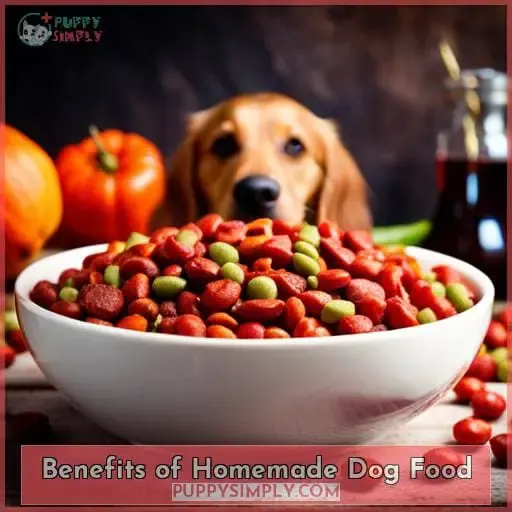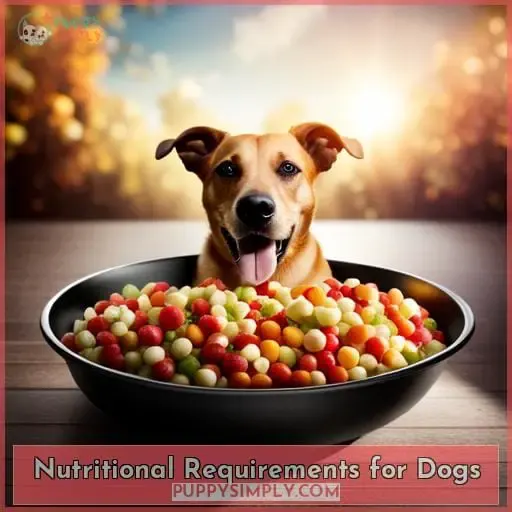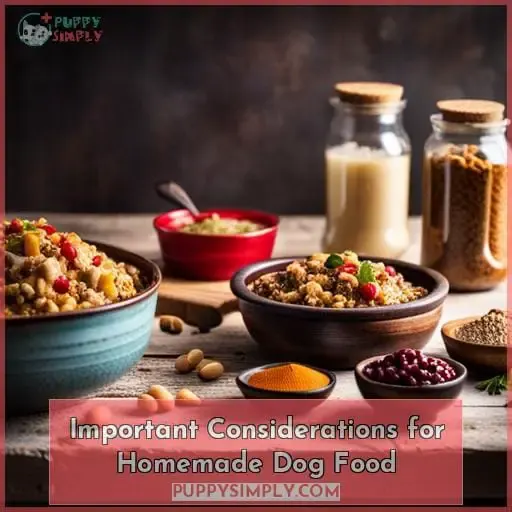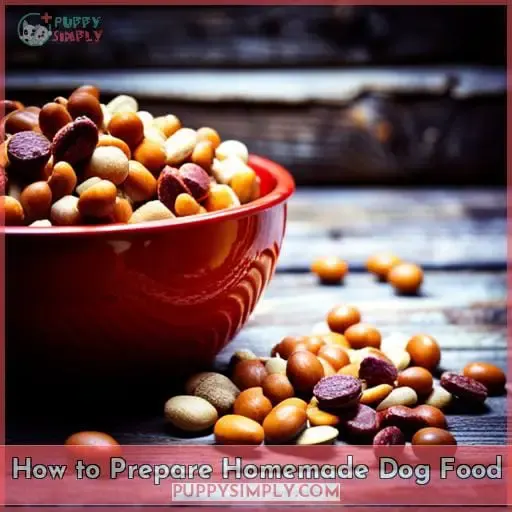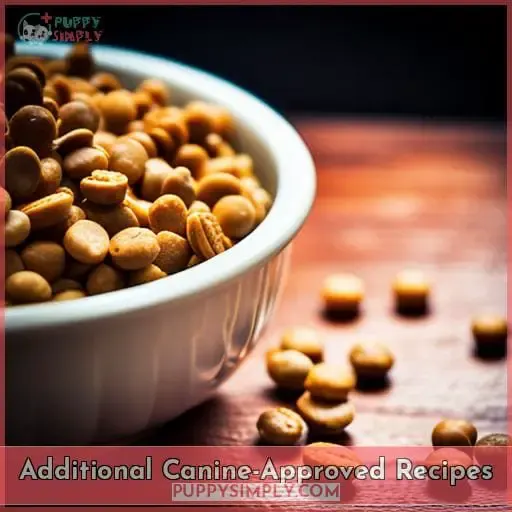This site is supported by our readers. We may earn a commission, at no cost to you, if you purchase through links.
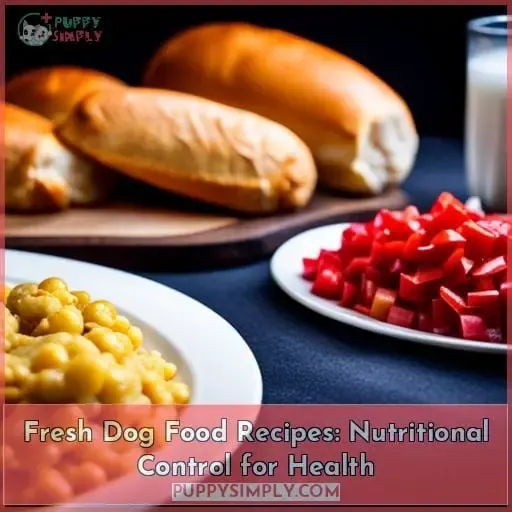 Are you looking for a way to give your pup the best nutrition? Homemade dog food may be the answer. Taking control of what goes into your furry friend’s diet allows for greater nutritional customization with fresh ingredients, while also providing cost-savings compared to store-bought brands.
Are you looking for a way to give your pup the best nutrition? Homemade dog food may be the answer. Taking control of what goes into your furry friend’s diet allows for greater nutritional customization with fresh ingredients, while also providing cost-savings compared to store-bought brands.
With a few simple recipes and understanding of canine dietary needs, you can create delicious meals that will keep Fido healthy and happy! Understanding how much protein, carbohydrates, fats, and fiber are necessary for optimal health in dogs can help ensure they get enough vitamins and minerals from their diet without overfeeding or underfeeding them.
Fresh dog food recipes provide an excellent opportunity to customize each meal based on individual needs as well as incorporating seasonal produce like pumpkin in autumn or spring greens all year round!
Table Of Contents
- Key Takeaways
- Benefits of Homemade Dog Food
- Nutritional Requirements for Dogs
- Important Considerations for Homemade Dog Food
- How to Prepare Homemade Dog Food
- Sample Dog Food Recipes
- Cooking Instructions and Storage Tips
- Additional Canine-Approved Recipes
- Consultation With a Veterinarian
- Applying Homemade Dog Food to Your Dog’s Diet
- Conclusion
Key Takeaways
- Homemade dog food offers nutritional control and cost savings.
- Customizing meals based on canine dietary needs is essential.
- Portion control is important to prevent obesity.
- Fresh homemade dog food promotes health and happiness.
Benefits of Homemade Dog Food
Are you considering making homemade dog food for your pet? It’s an excellent option due to the nutritional control and health benefits it provides, as well as its cost-effectiveness. Homemade recipes provide a variety of fresh ingredients that cater to your pup’s specific needs while keeping their diet balanced and nutritious.
Nutritional Control and Health:
Making your own dog food gives you the ultimate control over what nutrients your pup is taking in, making it easier to make sure they’re getting all of the vitamins and minerals their body needs. Nutritional analysis tables can help create homemade recipes that meet canine nutrition requirements.
With dietary guidelines from vets and ingredient control, you can ensure health benefits while giving them fresh dog food recipes.
Benefits include:
- Knowing exactly what ingredients are in each meal
- Easily adjust foods for dogs with allergies or special diets
- Control portion size based on age & activity level
- Make healthy snacks as treats
By understanding nutritional needs and creating meals tailored to your pet’s individual diet, homemade dog food will keep them healthier longer!
Cost-Effectiveness of Homemade Dog Food:
Consulting your vet and batch-prepping meals can help you save time and money while providing your pup with a nutritious homemade diet. Homemade dog food allows for ingredient control, nutrition balance, recipe variety, and health benefits that are not available in store-bought options.
You can adjust recipes to meet the needs of any breed or lifestyle without breaking the bank. Plus, fresh ingredients offer more nutritional value than processed versions found on shelves! Cooking for dogs is easier than most people think; just source quality ingredients to make sure they’re getting their daily nutrients at an affordable price.
With canine nutrition in mind, it’s easy to see why switching to homemade dog food has become so popular – its cost-effectiveness makes it a win-win choice!
Adjusting Recipes for Individual Dogs
Adjusting your homemade dog food recipes to suit your pup’s individual needs can be a great way for you to ensure their health and well-being. Consider customizing portions, dietary adaptations, and tailored ingredients based on breed type, age, activity level, or any special dietary requirements.
Speak with a vet about canine nutrition to get the best idea of what should go into each recipe. When creating fresh dog food recipes at home, make sure all components are present. Include protein sources like meat or beans, carbohydrates from grains, fiber from vegetables, and healthy fats.
Pet nutrition is essential, so adjust accordingly. Monitor closely for changes in weight or sensitivity before adjusting further if needed!
Nutritional Requirements for Dogs
Understanding your pup’s nutritional needs is key when creating a balanced homemade diet. Protein sources are essential for building and maintaining muscle mass, while dietary fiber helps with digestion and weight management.
Homemade treats can also provide essential vitamins and minerals to complete the canine nutrition equation.
Commercial alternatives may offer convenience, but they often include additives that aren’t ideal for dogs’ health or well-being. When cooking at home, it’s important to focus on fresh ingredients like lean meats and dog-friendly vegetables such as carrots or green beans.
Quality carbohydrates from grains like brown rice or oatmeal should be cooked until tender yet firm enough not to be mushy in texture once cooled down after serving the meal.
Finally, remember that portion control is just as important. If too much food is given, then obesity can occur.
Important Considerations for Homemade Dog Food
When considering homemade dog food, it is important to take into account the nutritional requirements specific to dogs and consult your vet for advice. Additionally, storage and portion control are essential components of feeding a healthy diet for your canine companion.
Nutritional requirements for dogs
Knowing your dog’s nutritional requirements can help ensure their optimal health and wellbeing. Protein, carbohydrates, fat, and fiber are important components of a balanced diet for dogs. Dietary needs vary depending on age and activity level, so it is important to consult your vet to calculate caloric intake accordingly.
Homemade recipes provide control over ingredients, while fresh dog food recipes offer nutrient-rich options with minimal processing. Canine nutrition should be monitored when switching diets since homemade preparation requires specific measurements for accuracy in ingredient amounts, which affects the overall quality of the dish.
Finally, regular monitoring of weight and health indicators is essential as adjustments may need to be made from time to time based on feedback from both you and your pet!
Importance of veterinary consultation
It’s vital to consult your vet before changing your pup’s diet. A balanced homemade dog diet requires protein, carbs, fiber, fat, and supplements tailored to the canine’s nutritional needs.
Storage and portion control
Manage your pup’s portion sizes and store homemade meals using the fridge or freezer for optimal freshness. Portion size depends on age, breed, weight, activity level, and health conditions.
Meal planning can help save time when making multiple batches of food at once to freeze for later use. Choose a storage container that’s airtight with plenty of space in case you need to add additional food items like supplements or vegetables as needed.
Freezing will help preserve nutrients for up to two months but should be used sparingly since cooked dog foods are more vulnerable than raw diets. This is because the heat destroys beneficial bacteria and enzymes found naturally in some ingredients such as ground greens and cod liver oil, which can’t be replaced by adding them after cooking takes place.
Freshness is key. Make sure you’re monitoring how long dog food stays out before refrigerating it again if necessary!
How to Prepare Homemade Dog Food
You can easily make homemade dog food at home, controlling the ingredients to suit your pup’s needs.
- Consult with your vet on canine dietary needs and adjust ingredient ratios accordingly.
- Use a food scale for accuracy when measuring ingredients.
- Incorporate nutrient-rich vegetables like spinach, carrots, zucchini, or peas into recipes.
- Follow cooking guidelines and storage instructions carefully to ensure the safety of the food you prepare for your pet’s consumption.
When preparing homemade dog food recipes, always prioritize their health by taking diet changes slowly over time. Monitor any signs of sensitivity along the way. For extra caution, speak with an experienced veterinarian who has knowledge about canine dietary requirements to supplement any nutritional gaps that may be present within certain meals or diets considered for feeding.
Sample Dog Food Recipes
If you are looking to switch your dog’s diet from store-bought food to homemade meals, there are two sample recipes that you should be aware of: MSPCA-Angell’s recipe for a 15 lb dog and Northwest Holistic Pet Care’s recipe for a 20 lb dog.
Both include protein sources such as chicken or turkey, vegetables, and supplements.
MSPCA-Angell Recipe
Delight in MSPCA-Angell’s recipe for a 15 lb pup, featuring chicken, rice, and veggies packed with supplements. This balanced meal provides just the right nutritional balance for your canine companion.
Veterinary guidance will help you adjust ingredients to suit their size and activity level.
Follow cooking instructions, then store it safely in the fridge or freezer until needed – up to two months! Serving up fresh dog food recipes is an easy way to provide the healthy sustenance your pooch needs without compromising on taste.
With careful ingredient adjustments combined with expert pet nutrition advice, preparing meals at home can be one less worry when caring for our furry friends!
Northwest Holistic Pet Care Recipe
Take a look at Northwest Holistic Pet Care’s recipe for an energizing and healthy homemade meal that’ll keep your pup going strong. This balanced diet includes turkey, vegetables, and supplements with ingredient adjustments based on the dog’s weight and activity level to provide dietary flexibility.
Other key elements of this fresh dog food recipe are:
- Turkey Variations
- Ingredient Adjustments
- Dietary Flexibility
- Vet Consultation
This simple yet nutritionally sound recipe offers all the benefits of homemade pet food without sacrificing flavor or nutrition, ensuring that your four-legged friend stays happy and healthy!
Cooking Instructions and Storage Tips
Prepare homemade dog food with care to ensure it’s nutritious and safe for your pup, from cooking and cooling to storing in the fridge or freezer.
- Cooking techniques – Use gentle heat to preserve nourishing ingredients like fresh vegetables, meats, grains, and supplements.
- Ingredient variety – Customize recipes by including foods that provide a balance of protein sources such as turkey or chicken, along with nutrient-dense carbs like brown rice or quinoa, plus veggies like spinach, carrots, zucchini, and peas.
- Freezing benefits – Batch preparation and freezing make feeding convenient while locking in flavor for up to 2 months if stored properly in freezer bags or airtight containers.
- Refrigeration tips – Store homemade dog food safely between 3-4 days at 40 degrees Fahrenheit (or 4 °C) below perishable items such as milk, eggs, cooked meat leftovers, etc.
With careful attention, you can guarantee safety, nutrition, and quality control every time you prepare fresh dog food recipes!
Additional Canine-Approved Recipes
You may be looking to switch up your pup’s regular diet. If so, you should try out some homemade dog food recipes! Not only are they cost-effective and filled with fresh vegetables, but you can also control the ingredients in each meal.
When crafting a balanced recipe for your pooch, ensure that it contains at least 50% protein (such as ground turkey or chicken), 25% grains like brown rice, and 25% vegetables like spinach and carrots.
| Ingredients | Measurement | Per Serving Calories |
|---|---|---|
| Chicken | 1 cup | 440 |
| Rice | 1/2 cup | |
| Veggies | 2 cups |
You can make this dish easily by cooking the rice separately before adding it to a pan of cooked ground turkey along with spinach, carrots, zucchini, and peas.
For additional nutrition benefits such as omega fatty acids or vitamins A & D, consider adding dietary supplements such as cod liver oil or ground greens into their meals too – just check with your vet first!
Dog treats are also an excellent way of giving variety while introducing new flavors into their diets. Homemade snacks could come in handy when training puppies or providing senior dogs extra nutrients throughout day-to-day activities around home.
With these recipes on hand, there’s no reason why you can’t give Fido his favorite dishes every day without having to worry about what goes inside them!
Consultation With a Veterinarian
Before making dietary changes, it’s wise to consult your vet for personalized advice. A veterinarian can provide guidance on the specific nutritional needs of your dog and help you adjust a homemade diet accordingly.
With their expertise in canine nutrition, they can also suggest supplements and offer advice on how to best prepare fresh pet food recipes. It is important to ensure that any ingredients used are safe for dogs, as some human foods may be toxic or not suitable for them.
During health consultations, vets will assess the condition of your pup before advising which type of diet would work best depending on breed size and weight, as well as activity level. They will help decide what kind of protein sources should be included in meals, along with other vital nutrients like carbohydrates, fats, vitamins, and minerals essential for growth or recovery from an illness if needed.
Your vet might even share sample recipes specifically tailored to suit individual needs, so you know exactly what goes into each meal! Your veterinarian is there every step of the way when adjusting diets; whether it’s deciding portion sizes or monitoring progress over time while keeping an eye out for any adverse reactions due to digestive upset caused by new ingredients being introduced too quickly!
Their nutritional expertise provides peace of mind, knowing that all areas have been covered when transitioning onto a homemade diet plan, providing maximum benefit without compromising safety standards set by professionals within this field – giving both pet owners reassurance that their furry friends remain healthy at all times through proper dietary adjustments based upon expert veterinary advice!
Applying Homemade Dog Food to Your Dog’s Diet
Once you’ve discussed your dog’s specific needs with a veterinarian, it’s time to apply homemade food into their diet. For the best results, tailor recipes to fit an individual canine’s dietary requirements and lifestyle.
Consider factors such as ingredient adjustments for weight and activity level when creating homemade dog food recipes.
Nutritional supplements can also be added, but should only be done with veterinary guidance. To ensure an appropriate balance of protein, carbs, fiber, and fat in each meal is maintained, samples provided by veterinarians are beneficial sources of ideas for a balanced diet that meet all nutritional needs for different life stages or activity levels of dogs.
It pays off to invest some time in learning about cooking tips needed when preparing meals at home. Gentle cooking techniques help retain nutrients from ingredients used, while veggie processing will provide more digestible meals which could help improve health issues like urinary pH if present in the past medical history of your pup companion.
The recipe shared here includes brown rice cooked first, then ground turkey being broken apart while sautéing until lightly golden. After that, add spinach, carrots, zucchini, peas, plus olive oil, and mix everything together so all flavors blend nicely.
Make sure portions given match daily calorie need calculations previously established between owners/pet parents and vets prior to switching diets completely. Otherwise, monitor any changes in pet behavior regularly until everything gets adapted properly over weeks due to its slow transition process recommended overall.
Conclusion
You have the power to keep your pup healthy and happy by providing them with fresh, homemade dog food recipes. Not only do you have better control over the quality of ingredients, but you can also tailor the meals to your pup’s individual needs.
With the right balance of proteins, carbs, fiber, fats, and supplements, you can create delicious, nutritious meals for your furry family member. Whether you choose MSPCA-Angell’s recipe for a 15 lb dog, Northwest Holistic Pet Care’s recipe for a 20 lb dog, or something entirely different, your pup will thank you for the fresh, high-quality food.
So don’t wait, start cooking fresh dog food recipes for your pup today!

